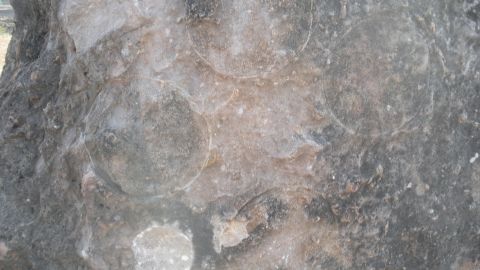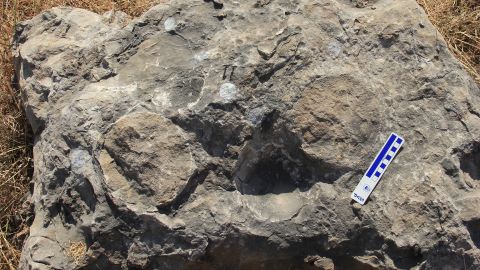Sign up for CNN’s Wonder Theory science newsletter. Explore the universe with news on fascinating discoveries, scientific advancements and more.
CNN
—
Paleontologists working in central India have made a rare discovery — a fossilized dinosaur hatchery with 92 nests and 256 eggs belonging to colonies of giant plant-eating titanosaurs.
A study of the nests and their bowling ball-size eggs has revealed intimate details about the lives of the colossal, long-necked sauropods that lumbered across what’s now central India more than 66 million years ago.
The eggs, which ranged between 15 centimeters and 17 centimeters (6 inches and 6.7 inches) in diameter, likely belonged to a number of titanosaur species. The number of eggs in each nest ranged from one to 20, said lead study author Guntupalli Prasad, a paleontologist in the department of geology at the University of Delhi. Many of the nests were found close together.
The findings suggested titanosaurs, among the largest dinosaurs to have lived, were not always the most attentive parents, Prasad said.
“Since titanosaurs were huge in size, closely spaced nests would not have allowed them to visit the nests to maneuver and incubate the eggs or feed the hatchlings … as the parents would step on the eggs and trample them.”
Finding a very large number of dinosaur nests is unusual, as preservation conditions have to be “just so” to have turned all the delicate eggs to fossils, said Dr. Darla Zelenitsky, an associate professor of dinosaur paleobiology at the University of Calgary in Canada, who studies dinosaur eggs. Zelenitsky was not involved in the research.

The first dinosaur eggs in the region were discovered in the 1990s, but the latest study focused on a nesting site in Dhar district in the state of Madhya Pradesh, where excavations and fieldwork took place in 2017, 2018 and 2020.
The eggs discovered there were so well preserved that the team was able to detect degraded protein fragments from the eggshells.
Titanosaurs’ nesting behaviors shared characteristics with that of today’s birds and crocodiles, the research suggested.
From the close proximity of the nests, researchers inferred the dinosaurs laid eggs together in colonies or rookeries, as many birds do in the present day.
“Such nesting colonies would have been a sight to see back in the Cretaceous where the landscape would have been dotted by a huge number of large dinosaur nests,” Zelenitsky said.
Prasad said one particular egg — known as an ovum-in-ovo, or egg-in-egg — the team had studied showed birdlike reproductive behavior and indicated that, similar to birds, some dinosaurs may have laid eggs sequentially. Ovum-in-ovo forms happen in birds when an egg becomes embedded in another egg still in the process of forming before they are laid.
“Sequential laying is the release of eggs one by one with some time gap in between two laying events. This is seen in birds. Modern reptiles, for example turtles and crocodiles, on the other hand, lay all eggs together as a clutch,” he said.
The eggs would have been laid in marshy flatlands and buried in shallow pits, akin to the nesting sites of modern-day crocodiles, Prasad said. Similar to crocodile hatcheries, nesting close to water may have been important to prevent the eggs from drying out and offspring dying prior to hatching, Zelenitsky added.

But unlike birds and crocodiles, which both incubate their eggs, Prasad said that, based on the physical characteristics of the nests, titanosaurs likely laid their eggs and then left the baby dinos to fend for themselves — although more data is needed to be sure.
Other dinosaurs were thought to be more attentive parents. A dinosaur was discovered in Mongolia in the 1920s, for example, lying near a nest of eggs thought to belong to a rival. Paleontologists at the time assumed the animal had died while attempting to plunder the nest — and named the creature oviraptor, or “egg thief.”
The so-called dinosaur thief’s reputation wasn’t restored until the 1990s, when another discovery revealed the eggs were, in fact, its own and that the creature likely sat upon them in a neatly arranged nest.